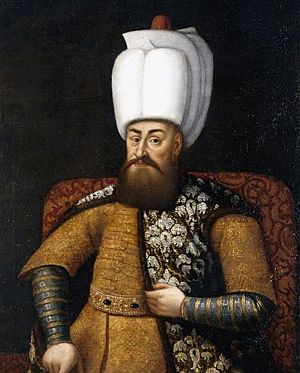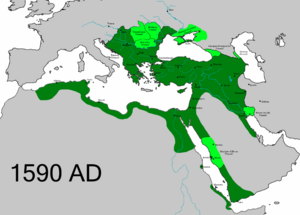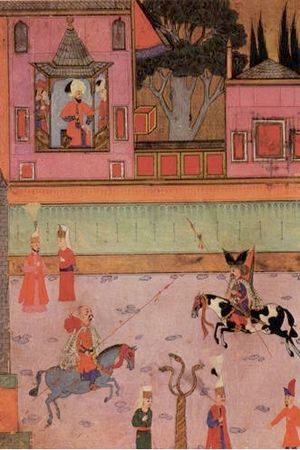Murad III facts for kids
Quick facts for kids Murad III |
|||||
|---|---|---|---|---|---|
| Kayser-i Rûm Ottoman Caliph Amir al-Mu'minin Custodian of the Two Holy Mosques |
|||||

Life-size portrait, attributed to a Spanish artist, 17th century
|
|||||
| Sultan of the Ottoman Empire (Padishah) | |||||
| Reign | 27 December 1574 – 16 January 1595 | ||||
| Predecessor | Selim II | ||||
| Successor | Mehmed III | ||||
| Born | 4 July 1546 Manisa, Ottoman Empire |
||||
| Died | 16 January 1595 (aged 48) Topkapı Palace, Constantinople, Ottoman Empire |
||||
| Burial | Hagia Sophia, Istanbul | ||||
| Consorts |
|
||||
| Issue | Mehmed III Others |
||||
|
|||||
| Dynasty | Ottoman | ||||
| Father | Selim II | ||||
| Mother | Nurbanu Sultan | ||||
| Religion | Sunni Islam | ||||
| Tughra |  |
||||
Murad III (born 4 July 1546 – died 16 January 1595) was a powerful ruler of the Ottoman Empire. He was the Sultan from 1574 until his death in 1595. During his time as Sultan, the Ottoman Empire fought many wars. These included battles with the Habsburgs and long conflicts with the Safavids.
Murad III also helped the Ottoman Empire grow its influence along the eastern coast of Africa. He was a big supporter of the arts, ordering many beautiful books and paintings. His reign also saw stronger ties with Elizabethan England, as both empires shared a common enemy in Spain.
Contents
Early Life and Education
Murad was born in Manisa on 4 July 1546. He was the oldest son of Selim II and his mother, Nurbanu Sultan. Murad received a very good education. He learned to speak both Arabic and Persian.
In 1557, his grandfather, Sultan Suleiman I, made him a governor (called a sancakbeyi) in Akşehir. When he was 18, he became the governor of Saruhan. After Suleiman died in 1566, Murad's father, Selim II, became the new Sultan. Selim II sent only Murad to govern a province, which was a new tradition.
Becoming Sultan
When his father, Selim II, died in 1574, Murad became the new Sultan. His rule began with a sad and harsh tradition: he had his five younger brothers killed. This was done to prevent any challenges to his power.
Murad's rule was sometimes affected by the women in his palace. His mother, Nurbanu Sultan, and later his favorite wife, Safiye Sultan, had a lot of influence. This sometimes weakened the power of his Grand Vizier, Sokollu Mehmed Pasha, who was a very strong leader. Sokollu Mehmed Pasha stayed in his important role until he was killed in 1579.
Wars and Conflicts
Murad III's time as Sultan was filled with many difficult wars. The Ottoman Empire fought on its western and eastern borders. One notable defeat for the Ottomans was the Battle of Sisak.
Morocco Expedition
Abd al-Malik was a trusted friend of the Ottomans. He suggested that Morocco could become a vassal state of the Ottoman Empire. This meant Morocco would be under Ottoman control but still have its own ruler.
In return, Murad III would help Abd al-Malik become the ruler of Morocco. So, an army of 10,000 soldiers, mostly Turks, left from Algiers. They helped Abd al-Malik take control of Fez and Marrakesh. Abd al-Malik then ruled Morocco as an Ottoman client.
Abd al-Malik paid the Ottoman troops a lot of gold to send them back. This showed a looser connection than Murad III might have expected. Murad's name was used in prayers and on coins, which were signs of his power. However, Abd al-Malik's brother, Ahmad al-Mansur, later stopped using Murad's name and declared full independence in 1582.
War with the Safavids
The Ottoman Empire had been at peace with the Safavid Empire since 1555. But in 1577, Murad decided to declare war. He wanted to take advantage of the problems in the Safavid court after their Shah (ruler) died.
This war, called the Ottoman–Safavid War, lasted for 12 years. It ended with the Treaty of Constantinople (1590). This treaty gave the Ottomans significant new lands for a while.
Activity in Africa
During Murad's reign, an Ottoman Admiral named Mir Ali Beg helped the Ottoman Empire gain control over several cities on the Swahili coast. These cities included Mogadishu, Barawa, Mombasa, and Kilwa. Ottoman power was recognized in Mogadishu in 1585.
Economic Challenges
Murad's time as Sultan was tough financially for the Ottoman Empire. To keep up with new military methods, the Ottomans trained soldiers to use firearms. They paid these soldiers directly from the government treasury.
By 1580, a lot of silver from the New World caused high inflation. This meant money was worth less, and prices went up. This led to social problems, especially among soldiers and government workers who were paid with money that had less value. People also faced hardship from rebellions and a growing population.
Competition for jobs in the government became very strong. This led to bribery and corruption. Some sources even say that Murad himself accepted large bribes.
Alliance with England
Sultan Murad III and Queen Elizabeth I of England exchanged many letters and messengers. Murad thought that Islam and Protestantism had more in common with each other than with Roman Catholicism. He suggested an alliance between England and the Ottoman Empire.
England sent important materials like tin, lead (for cannons), and ammunition to the Ottoman Empire. Elizabeth even discussed working together with Murad III against their shared enemy, Spain, when war broke out in 1585. This friendly relationship continued with Murad's son, Mehmed III, and his wife, Safiye Sultan.
Life in the Palace
Like his father, Murad III was one of the few Ottoman Sultans who never left the capital city, Constantinople, for military campaigns. In his later years, he rarely even left the Topkapı Palace. For two years in a row, he did not attend the Friday prayer at the imperial mosque, which was very unusual.
Some historians wrote that Murad was afraid of plots by the Janissaries (elite soldiers) to remove him from power if he left the palace. Murad mostly stayed away from his people. He spent most of his time with a few close companions and followed a daily routine based on the five Islamic prayers.
Women and Eunuchs at Court
Important women in Murad's court included his mother, Nurbanu Sultan, and his sister, Ismihan Sultan. His wife, Safiye Sultan, became the most influential woman after his mother and sister passed away.
The palace also had many eunuchs. Before Murad, most eunuchs were white. But in 1582, Murad gave an important role to a black eunuch. By 1592, black eunuchs mainly guarded the Sultan and the women, while white eunuchs guarded the male pages. The chief black eunuch was called the Kizlar Agha, and the chief white eunuch was the Kapi Agha.
Murad and the Arts
Murad III was very interested in the arts, especially miniature paintings and books. He strongly supported the court's artists. He ordered several important books, including the Siyer-i Nebi, which is a heavily illustrated book about the life of the Islamic prophet Muhammad. He also commissioned the Book of Skills, the Book of Festivities, and the Book of Victories.
Murad also had two large stone urns brought from Pergamon and placed in the Hagia Sophia mosque in Constantinople. A large wax candle he donated to the Rila monastery in Bulgaria is still on display there.
Murad also wrote parts of Kitabü’l-Menamat (The Book of Dreams). This book was for his spiritual guide, Şüca Dede. It contains Murad's own descriptions of his spiritual experiences and dreams. In these dreams, he saw himself doing amazing things, like fighting many enemies, walking on water, and even going to heaven. He often met the Prophet Muhammad in his dreams.
Death and Burial
Murad III passed away from what is believed to be natural causes on 16 January 1595. He died at the Topkapı Palace in Constantinople. He was buried in a special tomb next to the Hagia Sophia mosque.
His mausoleum (burial place) holds 54 coffins, including his own, those of his wives, and his children. Murad also changed the burial customs for the mothers of Sultans. He had his mother, Nurbanu, buried next to her husband, Selim II. This made her the first royal wife to share a Sultan's tomb.
Family Life
Murad III had many children. His main wife was Safiye Sultan, who was from Albania. She was a very important figure in the palace.
Sons
Murad III had at least 25 known sons. When he died in 1595, his oldest son, Mehmed III, became the new Sultan. Following a harsh Ottoman tradition, Mehmed III had his 19 half-brothers killed to secure his own rule.
Some of Murad's known sons include:
- Sultan Mehmed III (born 1566), who became the next Sultan.
- Şehzade Selim (born around 1567).
- Şehzade Mahmud (born 1568).
- Many other sons who died young or were executed when Mehmed III became Sultan.
Daughters
Murad III had at least 30 daughters who were alive when he died in 1595. Sadly, 17 of them died from plague or smallpox in 1598. The names of many of his daughters are not known.
Some of Murad's known daughters include:
- Hümaşah Sultan (born around 1564).
- Ayşe Sultan (born around 1565).
- Fatma Sultan (born around 1573).
- Mihrimah Sultan (born around 1579 or 1592).
- Fahriye Sultan (died 1656).
- Rukiye Sultan.
- Mihriban Sultan.
- Hatice Sultan (born 1583).
- Fethiye Sultan.
Murad III in Popular Culture
- Murad III is shown in the movie Michael the Brave, played by Romanian actor Colea Rautu.
- The historical novel My Name is Red (1998) by Orhan Pamuk takes place at Murad III's court. The Sultan is called "Our Sultan" in the book.
- The book The Harem Midwife by Roberta Rich is a historical fiction story set in Constantinople in 1578. It follows a midwife who works with the women in Sultan Murad III's harem.
- In the 2011 TV series Muhteşem Yüzyıl, Turkish actor Serhan Onat plays Murad III.
See also
 In Spanish: Murad III para niños
In Spanish: Murad III para niños



